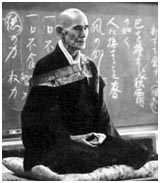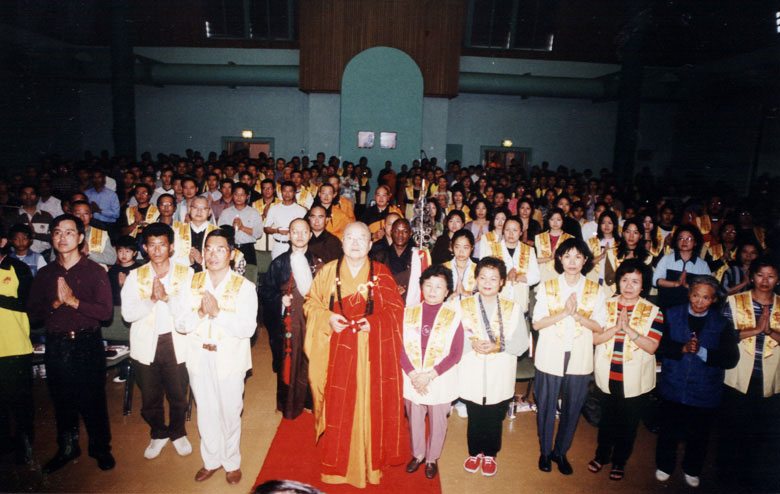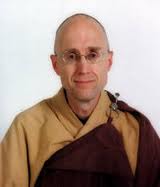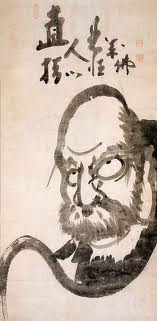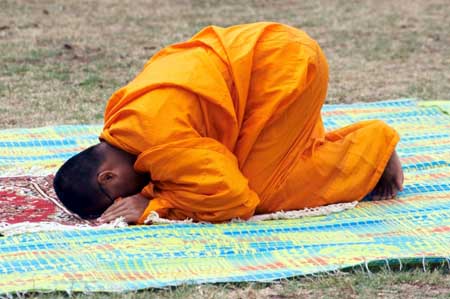Let’s move on to prostration practice. It’s a practice that needs to be built up gradually over time and not rushed into. We recommend starting with nine prostrations per day and working up to the larger numbers as the counting technique is learned. The counting technique does not involve counting the prostrations with numbers.
There are no external entities to whom we bow. There is no “out there,” no mind and body within, no world without.
Roshi Yasutani called prostrations “the horizontalizing of the mast of ego.” We bow to our inherent Buddha nature, which is, in the words of the Ten Verse Kanzeon chant, eternal, joyous, selfless, pure.
(1885-1973)
We begin standing erect, facing a Buddha statue if available, or just empty space if we prefer. We can use a yoga or pilates mat, or just a towel on a carpet.
1. We squat down and place our hands in front of us, preferably one hand at a time, and then rock forward so that our knees are on the floor. Our left hand is on the mat in front of our left knee and our right hand is on the mat in front of our right knee, palms down. Our hands may be further apart than our knees and our hands may be just a few inches in front of our knees.
2. We lift our feet so that our toes can lie flat with the top surface of the toes overlying the floor.
3. We bend our elbows and lower our head to the floor or mat, touching our forehead.
4. With our neck muscles now supporting our torso, we lift our hands, move them forward, turn the palms up and shift the torso weight back to our arms. We lift both palms together about six inches or so, hold them there for a moment, and return them to the floor, still palms up, pausing a moment just above the floor before putting them down. We may visualize when lifting the hands that we are lifting the Buddha or the Buddhadharma (the teachings of the Buddha).
5. Then we turn both palms back to the floor, lift our feet so that the bottom surface of the toes once again overlie the floor, and return to a standing posture.
The Chinese version differs from the Japanese version just described in that instead of lifting the hands when the palms are turned up, the hands remain down, the fingers are closed to form a fist, re-opened, and then the hands are turned palms down for returning to the standing posture.
Flexible people can drop to their knees before placing their hands in front of them, and they can rock back to a standing position after completing the prostration without using their hands to push up from the floor.
Here is a short YouTube video of someone I don’t know demonstrating three prostrations. I have always wanted to say “Thank You” to that fellow for his excellent demonstration. He performs each prostration quickly but we can go more slowly.
Prostrations may seem at first glance to have religious overtones. However, nothing in Buddhism is religious because there is no Great Entity out there to whom we must re-connect.
Religious people tell their god or savior that they are sorry for not believing in them earlier, or not following their teachings earlier.
Taking refuge in the Buddha, the Dharma, and the Sangha, on the other hand, recognizes that there is no independent entity outside ourselves that we can say “I’m sorry” to.
Taking Refuge with Master Hsing Yun
(founder of Fo Guang Shan, Buddha Light Mountain)
All recitations are silent, inward, not spoken.
With the first nine prostrations, we recite Taking Refuge in the Buddha, Dharma and Sangha (just the words, not the number, of course):
1. I take refuge in the Buddha and resolve that with all beings I will understand the Great Way whereby the Buddha seed may forever thrive.
2. I take refuge in the Dharma and resolve that with all beings I will enter deeply into the sutra treasure whereby my wisdom may grow as vast as the ocean.
3. I take refuge in the Sangha and in its wisdom, example, and never failing help, and resolve to live in harmony with all sentient beings.
4. For a second time, I take refuge in the Buddha and resolve that with all beings I will understand the Great Way whereby the Buddha seed may forever thrive.
5. For a second time, I take refuge in the Dharma and resolve that with all beings I will enter deeply into the sutra treasure whereby my wisdom may grow as vast as the ocean.
6. For a second time, I take refuge in the Sangha and in its wisdom, example, and never failing help, and resolve to live in harmony with all sentient beings.
7. For a third time, I take refuge in the Buddha and resolve that with all beings I will understand the Great Way whereby the Buddha seed may forever thrive.
8. For a third time, I take refuge in the Dharma and resolve that with all beings I will enter deeply into the sutra treasure whereby my wisdom may grow as vast as the ocean.
9. For a third time, I take refuge in the Sangha and in its wisdom, example, and never failing help, and resolve to live in harmony with all sentient beings.
Obviously, these nine prostrations are simply taking refuge in the Buddha, Dharma and Sangha three times. This is the traditional way of taking refuge.
After we are used to nine prostrations and have memorized the Taking Refuge chants, we can gradually do more prostrations.
To increase our daily prostration practice from nine to twelve, we recite the Repentance Gatha three times.
10. All evil deeds committed by me since time immemorial, stemming from greed, anger and delusion, arising from body, speech and mind, I now repent having committed.
11. For a second time, all evil deeds committed by me since time immemorial, stemming from greed, anger and delusion, arising from body, speech and mind, I now repent having committed.
12. For a third time, all evil deeds committed by me since time immemorial, stemming from greed, anger and delusion, arising from body, speech and mind, I now repent having committed.
We can substitute “ignorance” for “delusion” if we prefer.
With the 13th-15th prostrations, we recite the Three General Resolutions:
13. I resolve to avoid evil.
14. I resolve to do good.
15. I resolve to liberate all sentient beings.
We next recite the Four Noble Truths (ariya sacca).
16. All compounded things are unsatisfactory/dukkha.
17. The origin of dukkha is craving/tanha, conditioned by ignorance/avijja, is dukkha samudaya.
18. Dukkha can be brought to cessation, dukkha nirodha.
19. The path to cessation of dukkha is the eightfold path, ariyo atthangiko maggo.
The next five recitations relate to the Five Hindrances (re-word as desired):
20. I resolve to overcome sense desire (by practicing Silent Present Moment Awareness).
21. I resolve to overcome ill will/anger/hatred (by practicing Loving Kindness (metta) meditation).
22. I resolve to overcome physical sloth (by performing prostrations, for example) and mental torpor (by making the recitals that accompany each prostration, for example).
23. I resolve to overcome restlessness and worry (by practicing every day).
24. I resolve to overcome doubt (by observing how I change as I continue practicing every day).
With prostrations twenty-five to thirty-two, we recite the eight folds of the Eightfold Path, (ariyo atthangiko maggo), also known as the path leading to cessation/nirodha of suffering/dukkha, or dukkha nirodha gamini patipada.
25. Right understanding, samma ditthi, is the first fold.
26. Right thought, samma sankappa, is the second fold.
27. Right speech, samma vacha, is the third fold.
28. Right action, samma kammanta, is the fourth fold.
29. Right livelihood, samma ajiva, is the fifth fold.
30. Right effort, samma vayama, is the sixth fold.
31. Right mindfulness, samma sati, is the seventh fold.
32. Right concentration, samma samadhi, is the eighth fold.
The next ten prostrations are recited with the Ten Cardinal Precepts as worded by Roshi Philip Kapleau.
33. I resolve not to kill, but to cherish all life.
34. I resolve not to take what is not given, but to respect the things of others.
35. I resolve not to engage in improper sexuality, but to lead a life of purity and self-restraint.
36. I resolve not to lie, but to speak the truth.
37. I resolve not to cause others to take substances that impair the mind, nor to do so myself, but to keep the mind clear.
38. I resolve not to speak of the faults of others, but to be understanding and sympathetic.
39. I resolve not to praise myself and to disparage others, but to overcome my own shortcomings.
40. I resolve not to withhold spiritual or material aid, but to give them freely when needed.
40. I resolve not to indulge in anger, but to exercise restraint.
42. I resolve not to revile the Three Treasure (the Buddha, the Dharma and the Sangha), but to cherish and uphold them.
We conclude the first half of the traditional one hundred eight prostrations by reciting the twelve nidayas of the doctrine of Dependent Origination or Dependent Arising.
The Pali term for Dependent Origination is pratityasamupada.
43. The arising of ignorance (avijja) leads to volition. (Avijja paccaya sankhara)
44. The arising of volition (sankhara) leads to consciousness. (Sankhara paccaya vinnanam)
45. The arising of consciousness (vinnana) leads to name and form. (Vinnana paccaya namarupam)
46. The arising of name and form (nama-rupa) leads to the six sense organs. (Nama-rupa paccaya salayatanam)
47. The arising of the six sense organs (the five senses plus the mind) (salayatana) leads to contact. (Salayatana paccaya phasso)
48. The arising of contact (phassa) leads to feeling. (Phasso paccayam vedana)
49. The arising of feeling (vedana) leads to craving. (Vedana paccaya tanha)
50. The arising of craving (tanha) leads to clinging. (Tanha paccaya upadanam)
51. The arising of clinging (upadana) leads to becoming. (Upadana paccaya bhava)
52. The arising of becoming (bhava) leads to birth. (Bhava paccaya jati)
53. The arising of birth (jati) leads to old age, sickness, and death. (Jati paccaya jara-maranam)
54. The arising of old age, sickness and death (jara-marana) leads to sorrow, lamentation, pain, grief and despair. (soka-parideva-dukkha-domanassupayasa sambhavan’ti)
Only after we have become comfortable with fifty four daily prostrations should we move on to one hundred eight by reciting the Prajna Paramita Hridaya (Heart Of Perfect Wisdom), more commonly known as The Heart Sutra:
55. The Bodhisattva of Compassion
56. from the depths of prajna wisdom
57. saw the emptiness of all five skandas
58. and sundered the bonds
59. that cause all suff’ring.
60. Know then:
61. Form here is only emptiness,
62. emptiness only form.
63. Form is no other than emptiness,
64. emptiness no other than form.
65. Feeling, thought and choice
66. consciousness itself
67. are the same as this.
68. Dharmas here are empty,
69. all are the primal void.
70. None are born or die.
71. Nor are they stained or pure,
72. nor do they wax or wane.
73. So in emptiness no form,
74. no feeling, thought or choice,
75. nor is there consciousness.
76. No eye, ear, nose,
77. tongue, body, mind;
78. no color, sound, smell, taste, touch,
79. or what the mind takes hold of,
80. nor even act of sensing.
81. No ignorance or end of it,
82. nor all that comes of ignorance.
83. No withering, no death,
84. no end of them.
85. Nor is there pain
86. or cause of pain
87. or cease in pain
88. or noble path to lead from pain,
89. not even wisdom to attain,
90. attainment too is emptiness.
91. So know that the Bodhisattva,
92. holding to nothing whatever
93. but dwelling in prajna wisdom,
94. is freed of delusive hindrance,
95. rid of the fear bred by it,
96. and reaches clearest nirvana.
97. All buddhas of past and present,
98. buddhas of future time
99. through faith in prajna wisdom
100. come to full enlightenment.
101. Know then the great dharani,
102. the radiant, peerless mantra,
103. the supreme, unfailing mantra,
104. the Prajna Paramita,
105. whose words allay all pain.
106. This is highest wisdom,
107. true beyond all doubt,
108. know and proclaim its truth:
This completes the 108 prostrations. We conclude the prostration practice while standing as we recite the Sanskrit ending:
Gate, gate (gone, gone)
paragate (gone beyond)
parasamgate (gone completely beyond)
bodhi, svaha! (enlightenment, rejoice!)
We chant the sanskrit words at the end, keeping in mind the translation.
The Heart Sutra is chanted daily in most monasteries and is believed to be chanted worldwide more than any other Buddhist chant. We did not introduce it in the chanting practice section above because it can be recited daily as the second half of the 108 prostrations.
Venerable Yin-Shun, a contemporary Chinese master (1906-2005), in The Way to Buddhahood. Boston: Wisdom Publications, 1998, recommends taking refuge as the first step in practicing Buddhism.
Master Yin-Shun, teacher of Cheng Yen
(1906-2005)
For the non-Buddhist who feels that taking refuge in the Buddha is objectionable, we recall that the Buddha is our own inherent awakened nature. Taking refuge in the Buddha is not an act of worship of a man who lived twenty five hundred years ago. We take refuge in our inherent perfect nature, a nature obscured by greed, hatred, and ignorance.
We don’t really take refuge in “our” inherent perfect nature. We don’t own anything and there is no “we” or “I.” Nor is there a Perfect Nature. Emptiness is all there is and it has no name, not even emptiness.
It is customary practice to perform a prostration as one takes refuge in the Buddha, a second prostration as one takes refuge in the Dharma, and a third prostration as one takes refuge in the Sangha. In a typical zendo, for example, there will be three prostrations at the end of a round of sitting.
Enlightenment appears like a thief in the night, unsummoned and unannounced. When the Christ said he would appear like a thief in the night, he was talking about enlightenment.
The second coming of Christ has occurred many times in the past two thousand years; whenever a sentient being wakes up, that is the second coming.
With our daily meditation practice, our daily chanting practice, and our daily prostration practice, we are creating the conditions that allow awakening to occur. We are Pratyeka Buddhas, awakening through self-effort, not waiting for a savior.
We should build up our prostration practice at our own pace. Some people go on retreats and do prostrations all day long.
Some Chinese-influenced practice centers promote the practice of performing 88 prostrations at a time; the number 108 apparently derives from Hindu sources and is the number of prostrations performed in the Tibetan Buddhist tradition. The Chinese consider 8 to be a lucky number, as the world learned when the Beijing Olympics began at 8 minutes after 8 o’clock on 08/08/08.
For inspiration, we can read Heng Sure and Heng Chau, News From True Cultivators: Letters to the Venerable Abbot Hua. Burlingame, CA: Buddhist Text Translation Society, 1983. That book will inspire almost everyone who reads it to start and maintain a prostration practice.
(well worth picturing multiple times)
If prostrations make us feel sick or physically upset in any way, we should not do them or at least not exceed the number we feel comfortable with. If we can only do three prostrations per day, we do them slowly and mindfully. That will be better than running through 88 or 108 in an athletic manner.
A single mindful prostration exceeds in value a countless number of mindless prostrations.
A young monk once asked his teacher: “When will I have performed enough prostrations?” The teacher replied: “When you have performed enough prostrations, you will know.”
We are not bowing to the Buddha when we perform prostrations, we are bowing to our inner Buddha nature, our original self. There is no one “out there.” The infinite Buddha is us, always has been and always will be because there is no yesterday, no tomorrow, no today, and no us that is independent from everything else.
There is no independent self, no other, no time, no space, no sun, no universe, no life, no death. We empty our cup if we believe otherwise.
All phenomena that appear to be external and real are just projections of our deluded, unenlightened minds. When we wake up and see what is really going on, we will have to have a good laugh.
However, we can’t experience the truth of mind alone until we have experienced the four jhanas, the four immaterial attainments, and turned the super power mindfulness thereby created to contemplation of the four foundations (focuses) of mindfulness, or impermanence, fading away, cessation and abandoning/letting go, all as set forth in the Anapanasati Sutta.
As Christian Science founder Mary Baker Eddy so astutely observed, all thoughts of health and sickness, God on the one hand and self on the other, are merely “mortal thoughts,” the thoughts of the deluded. How could we, on the one hand, bow to the Buddha on the other? The concept of bowing to some external agent is a deluded thought. There are no two things in emptiness, nor is there one thing or zero things or other mental perceptions.
The belief that there are two things is a mortal thought. How could there be a savior out there, separate and apart from us? Mary Baker Eddy, like the Buddha, had the insight that there are no seams in reality. So did Meister Eckhart who said: “The eye with which I see God is the same eye with which God sees me.”
And there is no god in emptiness. Nor is there emptiness in emptiness.
Performing prostrations also increases our sense of gratitude for the Buddhas of the past, present, and future. Here is the greatest story ever told about gratitude:
In the eighteenth century, a samurai warrior was determined to bring all of Japan under his control. Assembling an army of like-minded ruffians, he attacked his first town and slaughtered the inhabitants without mercy. “When people see how ruthless I am,” he predicted, “they will stop resisting my advance and I will be the Emperor above all.”
A few people escaped from the destroyed town and warned the people in the next town down the road that a warrior who lacked mercy was approaching. The people of that town fled and the warrior was quite pleased when he learned that they had done so. “My strategy of putting all who resist me to the sword is working,” he smiled.
One day, however, his scouts did not make the usual report. Instead, they said: “The next town has been evacuated, Your Highness, thereby coming under your control and expanding yet further your majestic empire. However, there is one old Zen monk who declined to leave his monastery when we warned him of your approach.”
The warrior was angered. “How dare an old man resist me! I will teach him a lesson.” He stormed into the monastery, saw the monk sitting on the floor in the lotus position, pulled out his sword and roared: “Don’t you know who I am?” The old monk responded by saying: “Sorry, sir, but I do not know who you are.”
Brandishing his sword, the warrior said, with pride: “I am the one who could run you through, and think nothing of it.” To this the old monk responded: “Pleased to meet you. And I am the one who could be run through and think nothing of it.”
This reply so astonished the warrior that he sheathed his sword and said: “To face me so fearlessly, to be so unafraid of my sword, you indeed are a better man than I am. I see that you are a monk, a holy man. Teach me about heaven and hell. I have heard of these things but I never received an education on these matters.”
“I do not teach dogs or swine such as yourself,” replied the monk, without looking up.
Needless to say, the warrior was incensed by that answer and quickly retrieved his sword. Trembling with anger, he raised it high over his head, the better to decapitate the monk with a single stroke.
“That is hell,” said the monk.
“What did you say?” inquired the warrior. “This is hell? This anger? This hatred?” “Yes,” affirmed the monk.
“I see,” said the warrior. “Oh! I understand! This desire to kill, this feeling that comes with wanting to kill someone! So that’s hell! It’s such a terrible feeling! As I prepared to bring my sword down on your neck, I felt so bad! My rage made me truly miserable.”
“You did teach me! I have learned what hell is! Thank you kind sir for this lesson. Thank you, Thank you!”
And the old monk looked up and said: “And that’s heaven.”
I first ran across that delightful (even if apocryphal) story in Zen Flesh, Zen Bones, the cite for which is Paul Reps, and Nyogen Senzaki, Zen Flesh, Zen Bones, A collection of Zen and Pre-Zen Writings.Boston: Charles E. Tuttle Co., 1957.
The warrior repented of his war-loving ways, and became a disciple of the monk who could be run through and think nothing of it – legend says it was Master Hakuin.
If we haven’t yet committed to memory Master Hakuin’s Chant in Praise of Zazen, let’s do it now. See Norman Waddell, Wild Ivy: The Spiritual Autobiography of Zen Master Hakuin. Boston & London: Shambhala, 2001.
Master Hakuin never mentioned an encounter with a warrior in his writings so we suspect the story is apocryphal – or it involved a monk or nun other than Hakuin – but it’s still a great story.
Master Hakuin (self portrait)
We have to do prostrations until we want to perform prostrations. And then we will increase our prostrations both in quantity and quality.
What is there outside us? What is there we lack? Nirvana is openly shown to our eyes. This earth where we stand is the pure lotus land, and this very body the body of Buddha.
There is no place to go, no thing to do, no goal to reach. Awakening is the realization that there is no one to awake, no one to fear being run through.
The Heart Sutra is a chant about emptiness, i.e., the absence of an independent self (“none are born or die”) and the concomitant interconnectedness of all sentient beings.
The Heart Sutra is a nickname; the Sanskrit title of this chant is Prajna Paramita Hridaya, which translates as The Perfection Of Wisdom Chant. Prajna means wisdom. Paramita means perfect or perfection and Hridaya means a long mantra, i.e., a chant.
So where does the title “Heart Sutra” come from? One source tells us that the original Prajna Paramita Sutra from which it is taken is very lengthy and the current verses were condensed from the longer sutra. These current verses are the most important phrases, i.e., the heart of the sutra. Another source says that it is a summary of other sutras such as The Diamond Sutra, The Lotus Sutra, The Avatamsaka Sutra, and so on, i.e., that it contains the heart of those sutras and thus the heart of the Buddha’s teachings.
Perhaps the best source of information about the Heart Sutra and more importantly, what it teaches, is Red Pine’s commentary. In my opinion, his book is priceless.
The Bodhisattva of Compassion, mentioned in the opening line of the Heart Sutra, sometimes translated as the Goddess of Mercy, is Guanyin, known in Japanese as Kanzeon or Kannon and sometimes called the Chinese Virgin Mary.
Guanyin came first so Mary is more fairly called the Guanyin of the West. This beautiful lady is called Avalokitesvara in Sanskrit and was a man in India; the Chinese made him into a woman. Perhaps they felt that compassion was more womanly than manly.
The “skandas” are the five aggregates that collectively form an apparent independent self.
The five aggregates are: Form, feeling, thought/perception, choice/volition, and consciousness.
A form or a body must exist before something can be touched to create a feeling and a feeling must exist before a thought can arise. No choice can be made until thoughts arise and there can be no consciousness without form, feeling, thought and choice.
Red Pine points out the connection between the four foundations of mindfulness as taught by the Buddha and the five skandas. The first two skandas are the body and feelings which match the first two foundations of mindfulness. The third foundation of mindfulness, that of the mind, is divided into the third, fourth and fifth skandas of thought, choice, and consciousness. The fourth foundation, mindfulness of mind objects, thus becomes subsumed into the fifth skanda.
The meaning of The Heart Sutra is not easily understood. It won’t make a lot of sense at first but Red Pine’s commentary is very beneficial and we highly recommend it.
The profound meaning of The Heart Sutra can sink in only with months or years of repetition. The unconscious mind will eventually figure it out.
any other chant. We did not introduce it in the chanting practice above because it can be recited daily as the second half of the 108 prostrations.
Chinese Pure Land Monks typically perform 500 prostrations per day. And thousands of Buddha Name Recitations.
Some of us perform the above 108 prostrations in the morning and would like to repeat the practice in the evening or night.
A good way to do a second set of 108 is to repeat the Taking Refuge prostrations, i.e., the first nine prostrations of the first set, followed by:
Recitation of the Four Brahma Viharas:
10. Metta (loving kindness)
11. Karuna (compassion)
12. Mudita (sympathetic joy, i.e. happiness in others happiness)
13. Upekkha (equanimity)
Then we recite the Six Paramitas (perfections):
14. Dana (generosity)
15. Sila (keeping the precepts)
16. Viriya (energy)
17. Ksanti (patience, tolerance)
18. Dhyana (meditation)
19. Prajna (wisdom)
Followed by the Seven Factors of Enlightenment:
20. Sati (mindfulness)
21. Dhamma vicaya (investigation)
22. Viriya (energy)
23. Piti (joy)
24. Passaddhi (tranquility)
25. Samadhi (concentration)
26. Upekkha (equanimity)
And the Ten Verse Kannon Sutra:
27. Kanzeon!
28. Praise to Buddha!
29. All are one with Buddha,
30. all awake to Buddha –
31. Buddha, Dharma, Sangha –
32. eternal, joyous, selfess, pure.
33. Through the day Kanzeon,
34. Through the night Kanzeon.
35. This moment arises from mind.
36. This moment itself is mind.
Kanzeon is Japanese for Quan Yin (Mandarin), the goddess of mercy or Bodhisattva of Compassion as mentoned above, whose full name is Quan Shi Yin which is why the Japanese transliteration has three syllables.
The final seventy two prostrations, i.e., prostrations 37-108, are reached by recitation of the Hsin Hsin Ming (Affirming Faith in Mind) which has 72 verses and which appears in the chanting section above.
Still another combination of 108 recitations consists of the first 54 lines of the Heart Sutra, with no prostrations for the Pali words of the final four lines as above, followed by the first fifty four lines of Master Hakuin’s Chant in Praise of Zazen, with no prostrations for the final four lines. Other combinations to reach 108 include the first 54 as recited above, followed by Master Hakuin’s Chant instead of the Heart Sutra.
If we simply count the prostrations, we miss an opportunity to learn the Taking Refuge vows, the Repentance Gatha, the Three General Resolutions, the Four Noble Truths, the Five Hindrances, the Eightfold Path, the Ten Precepts, and the Twelve Nidayas. We further miss the opportunity to learn the Four Brahma Viharas, the Six Paramitas, the Seven Factors of Enlightenment, the Ten Verse Kannon Sutra, and the seventy-two verses of the Hsin Hsin Ming, as well as the opportunity to recite Master Hakuin’s Chant in Praise of Zazen. We “learn” by daily repetition of these important verses. We already know how to count so reciting verses instead of counting makes sense.
